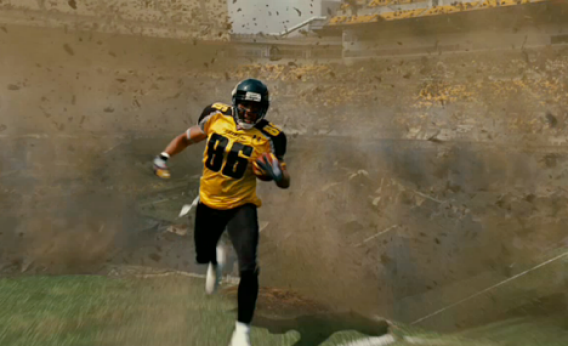When the opening action set-piece of The Avengers ends with the destruction of a remote research facility, the structure goes out not with a bang but more of a cool sucking noise. Meanwhile, in the first trailer for The Dark Knight Rises, Bane is set not on exploding a football stadium full of thousands of people so much as imploding it. In the second Dark Knight Rises trailer, released last week, rather than sending a bridge up in a fiery blast, a few tactical detonations send it neatly collapsing into the water.
We appear to be entering a boom in Hollywood implosions.
For the Hollywood blockbuster the implosion has many advantages over the explosion. The first and most obvious attraction is novelty. The implosion takes the rather well-worn Hollywood explosion and turns it inside-out—with none of those pesky balls of fire covering up the destruction. Explosions are fairly passé at this point, even boring: The filmmaker most closely associated with them is Michael Bay, who, according to one movie demolition expert, has included steadily more explosions in each movie he’s made (up through Transformers: Dark of the Moon, which reportedly contained a mind-numbing 283 explosions).
And while practical effects remain as expensive as ever, convincing computer-generated ones have become cheaper and cheaper. This has allowed action movies to escape even further from reality, abandoning C-4 and good old reliable stick dynamite for alien weaponry and wand blasts and repulsor beams. As Adam Sternbergh argued in the New York Times Magazine, explosions were once one of the three main components of the American action film, but then “computer animation gobbled up everything, chewing it all into weightless pixels.” Now it can be as cheap to make the fantastical look real as it is to stage carnage.
Or just compare a scene of planetary destruction in Star Wars (1977) with a similar scene in Star Trek (2009). In Star Wars a blast from the Death Star blows apart Alderaan in a hail of fireworks, but in Star Trek the Romulans inject “red matter” into the planet Vulcan, sending it slowly imploding in on itself until it turns it into a black hole. The effect in Star Trek is far more chilling, and it would perhaps never have been possible before the rise of CGI. (Indeed, while black holes have long been a subject of fascination in sci-fi flicks, they’ve usually been used—as others have noted—just for time and space travel.)
There’s at least one more reason the implosion may have added power these days: It evokes the most indelible image of 21st-century destruction, the one filmed on September 11th, 2001. The most frightening visual from that day was not the planes exploding into the towers, but the towers falling in on themselves. Hollywood has again and again demonstrated a willingness to infuse our popcorn flicks with heft and horror from that tragedy—most recently in The Avengers, as noted on last week’s Culture Gabfest—and, whether or not we’re conscious of it or not, the implosion does just that.
Meanwhile, an increasing number of our landmarks aren’t so much exploding or imploding in movies as falling over, as happens to skyscrapers in the trailers for both The Amazing Spider-Man and Battleship. (The trailer for the new G.I. Joe has no shortage of explosions, but one of the biggest set-pieces has London falling apart from underneath.) Cloverfield (2008), meanwhile, features at least one collapse—producer J.J. Abrams acknowledged that they wanted it to be cathartic for those traumatized by September 11th.
Implosions were rare-to-nonexistent in earlier Hollywood eras. Yes, the possessed house at the end of Poltergeist (1982) imploded, but hardly anything else in that era did. (There’s also the imploding head of Colonel Dietrich in Raiders of the Lost Ark (1981), but that seems to be a separate phenomenon altogether—and besides it’s matched by what seems to be a similarly imploding head in the latest trailer for Prometheus.) Even in Space Balls (1987), in which the enemy’s superweapon is a giant vacuum cleaner, its end is very much an explosion.
Of course, I don’t expect that the implosion will completely replace the explosion, which seems to tap into something primal, as if it were the tribal campfire. But if our visual effects continue to release us from the bonds of reality-based filmmaking, as seems likely, explosions may come to seem increasingly mundane, even quaint. After all, one need only look at the new trailer for a trailer for the 1980s nostalgia flick The Expendables 2, posted just last week, which is literally nothing but explosions. Explosions may already have gone retro.
Explosion comparison video edited by Chris Wade.
Previously
What The Artist Gets Wrong About Quicksand
The Rise and Fall of Action-Movie Jumping
